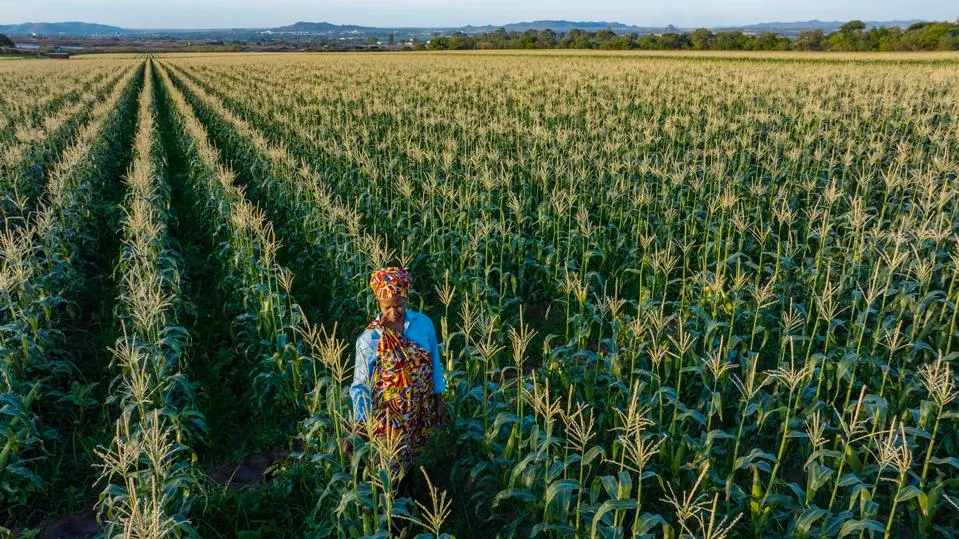Read in
Black African woman farmer in traditional clothing standing in a large corn crop in Africa/getty
One fundamental way to contrast the impact of artificial intelligence is to look at its applications in different industries – in healthcare, and education, in national administration – another way is to look at it on a regional basis.
We obviously have a lot of focus on the U.S. and China right now as these two empires race to develop new more powerful models. The DeepSeek announcement is just the newest wrinkle in a bone-deep rivalry that could very well decide a lot of the geopolitical realities of the rest of the twenty-first century.
But quietly, behind the scenes, other types of innovation are happening too, and some of these may have more to offer the world then than those widely publicized Sino-U.S. efforts to become the pre-eminent nation of origin for more efficient deep learning models.
AI in Ag
Case in point – AI is helping to feed the world. Agricultural solutions are coming to the table, including automatic harvesters and other labor-saving robotics, as well as key diagnostic tools that take a lot of the guesswork out of farming.
In a presentation recently, Jonas Sogbadji, who has studied robotics design and controls at the Ecole Nationale Supérieure d’Arts et Métiers in Paris, France, talked about how that’s taking on in Africa, where specific agricultural challenges abound.
“These farmers face many issues, including unpredictable weather, pests, and diseases, and lack of access to modern resources,” he said. Noting results like lower yields and food insecurity, Sogbadji took the example of Ghana, where a cocoa disease affected plants in recent years.
Forbes Daily: Join over 1 million Forbes Daily subscribers and get our best stories, exclusive reporting and essential analysis of the day’s news in your inbox every weekday.
Get the latest news on special offers, product updates and content suggestions from Forbes and its affiliates.
By signing up, you agree to our Terms of Service, and you acknowledge our Privacy Statement. Forbes is protected by reCAPTCHA, and the Google Privacy Policy and Terms of Service apply.
You can trace the supply chain pricing, he suggested, and see how that impacted the market, including the consumer end market.
So what can AI do?
Precision in Diagnosis
Sogbadji paint a picture of drone technologies hovering over crops, showing exactly where a disease is having an effect. Ground sensors will take data about the soil and add it into the mix.
Importantly, too, he said some of these technologies will translate for farmers, who only know a regional language.
“It can create jobs and potentially tackle malnutrition,” he said of these smart systems, which may soon be implemented all over the developing world.
“AI success does not just mean depleting diseases,” he said. “It means (the world) can tackle the unique agricultural challenges in Africa … with these tools, smallholder farmers can basically increase food security and decrease the impact of climate change, and globally, it just means more food quality for everybody.”
Food Efficiency and the Global Equation
We heard for years about how GMOs were going to “feed the world.” But GMOs are highly controversial. The idea of genetically modifying food is not a popular one in many countries.
Here’s how that’s explained by the World Health Organization:
“Since the first introduction on the market in the mid-1990s of a major GM food (herbicide-resistant soybeans), there has been concern about such food among politicians, activists and consumers, especially in Europe. Several factors are involved. In the late 1980s – early 1990s, the results of decades of molecular research reached the public domain. Until that time, consumers were generally not very aware of the potential of this research. In the case of food, consumers started to wonder about safety because they perceive that modern biotechnology is leading to the creation of new species.”
Different nations and regions have their own means of determining what’s safe: in Europe, for example, the Codex Alimentarius, a comprehensive guide to food regulations, provides guidance.
By contrast, using AI to micromanage crops is a process that doesn’t impact the quality of the food. If anything, it increases the quality, due to better management practices. It can also save massive amounts of chemicals from leaching into the environment around the crops. These are the kinds of solutions that actually solve the problems that we faced today, and we need them to counter agricultural practices that are reactive. People know, for example, that a lot of herbicide and pesticides are not attractive chemicals, or good for human health. But these were the solutions before the new AI technology came along. Let’s try to change agriculture and make it something that’s truly more sustainable for the future.



